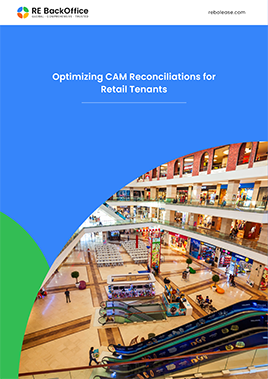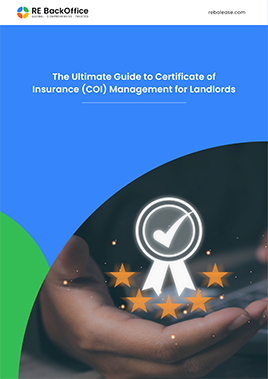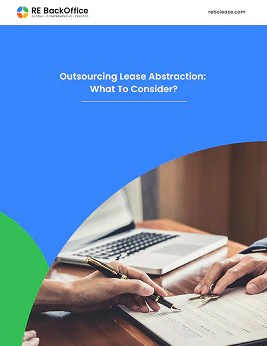
What is CAM Reconciliation?
Common Area Maintenance (CAM) reconciliation is a crucial process in commercial real estate that ensures the fair allocation of maintenance costs for shared spaces among tenants. CAM charges typically include expenses for maintaining and operating common areas such as lobbies, parking lots, landscaping, security, and other shared facilities.
CAM reconciliation involves comparing the estimated CAM costs charged to tenants throughout the year against the actual expenses incurred by the landlord. This annual reconciliation process determines whether tenants owe additional payments or are due refunds based on the actual costs.
The CAM Reconciliation Process
Estimation of CAM Charges:
At the beginning of the lease year, landlords estimate the CAM expenses based on historical data, anticipated costs, and budgets. These estimates are then divided among the tenants according to the terms specified in their leases.
Collection of CAM Charges:
Throughout the year, tenants make regular CAM payments, usually on a monthly basis. These payments are based on the estimated CAM costs.
Recording Actual Expenses:
Landlords meticulously track actual CAM expenses throughout the year. This includes costs for utilities, maintenance, security, cleaning, and any other services that contribute to the upkeep of common areas.
Reconciliation Statement Preparation:
At the end of the lease year, landlords prepare a reconciliation statement. This statement compares the estimated CAM charges collected from tenants against the actual expenses incurred.
Adjustments and Settlements:
If the actual expenses exceed the estimated charges, tenants may be required to pay the shortfall. Conversely, if the actual expenses are less than the estimated charges, tenants may receive a refund or credit towards future payments.
Benefits of CAM Reconciliation for Landlords
Let's delve into the various benefits and importance of CAM reconciliation for landlords.
Financial Accuracy: Ensuring Precise Cost Recovery
Financial accuracy is a cornerstone of effective property management.
CAM reconciliation ensures that landlords accurately recover the costs incurred in maintaining common areas. These areas, which include lobbies, hallways, parking lots, and landscaping, are essential for the functionality and appeal of commercial properties. Mismanagement or inaccurate tracking of these costs can lead to significant financial discrepancies.
Accurate CAM reconciliation provides landlords with a clear and precise understanding of expenses. By meticulously accounting for every dollar spent on maintenance, landlords can avoid overcharging or undercharging tenants. This precision is crucial for maintaining profitability and transparency, ensuring that all parties are fairly treated. Inaccurate reconciliation can lead to financial losses, eroding the trust between landlords and tenants, and potentially leading to legal complications.
Improved Budgeting: Refining Financial Planning
Regular CAM reconciliation offers invaluable insights that enhance the budgeting process. By consistently reviewing and reconciling maintenance costs, landlords gain a historical perspective on their expenditures. This historical data is instrumental in refining future budget estimates, allowing for more accurate financial planning.
Improved budgeting leads to better resource allocation and financial stability. Landlords can anticipate future maintenance needs and set aside appropriate funds, reducing the risk of unexpected expenses. This proactive approach not only ensures smooth operations but also contributes to the long-term sustainability and profitability of the property.
Tenant Relationships: Building Trust and Transparency
Transparent CAM reconciliation is fundamental to building strong relationships with tenants. Tenants are more likely to trust landlords who provide clear, detailed, and accurate breakdowns of maintenance costs. This transparency demonstrates a commitment to fairness and accountability, which are key components of successful property management.
Fostering good tenant relationships through transparent CAM reconciliation has several benefits. It encourages tenant retention, as satisfied tenants are more likely to renew their leases. Additionally, positive relationships can lead to referrals and a strong reputation in the market, attracting new tenants and reducing vacancy rates. Ultimately, transparent CAM practices create a cooperative and harmonious environment, benefiting both landlords and tenants.
Operational Efficiency: Identifying Cost-Saving Opportunities
CAM reconciliation is not merely a financial exercise; it also offers insights into operational efficiency. By analyzing maintenance costs and their allocation, landlords can identify areas where efficiencies can be improved and expenses reduced. This might involve renegotiating service contracts, implementing energy-saving measures, or optimizing maintenance schedules.
Operational efficiency gained through CAM reconciliation enhances the value of the property. Cost-saving opportunities can significantly reduce overall expenses, increasing the net operating income and the property's market value. Moreover, efficient operations contribute to a better tenant experience, as well-maintained common areas are crucial for tenant satisfaction and retention.
Legal Compliance: Avoiding Disputes and Litigation
Accurate CAM reconciliation is essential for legal compliance. Lease agreements often contain specific clauses regarding the calculation and allocation of CAM charges. Failing to comply with these terms can result in disputes between landlords and tenants, potentially leading to litigation.
By ensuring precise and transparent CAM reconciliation, landlords can avoid such disputes. Adherence to lease terms builds trust with tenants and protects landlords from legal challenges. It also demonstrates a commitment to professional and ethical property management, further enhancing the landlord's reputation.
Benefits of CAM Reconciliation for Tenants
Here's a closer look at the key benefits of CAM reconciliation for tenants.
Cost Transparency: Clear Understanding of Expenses
One of the primary benefits of CAM reconciliation for tenants is the transparency it provides. CAM charges can sometimes be a significant portion of a tenant's monthly expenses, and understanding these costs is essential. CAM reconciliation offers a detailed breakdown of maintenance expenses, enabling tenants to see exactly what they are paying for.
This transparency ensures that tenants are only charged for their fair share of maintenance costs. By having access to an itemized list of expenses, tenants can verify that the charges are accurate and justifiable. This clarity helps build trust between tenants and landlords, as it shows a commitment to honesty and accountability in the management of shared spaces.
Budget Management: Effective Financial Planning
Accurate CAM reconciliation aids tenants in managing their budgets more effectively. When tenants have a clear picture of the actual CAM costs, they can better anticipate future expenses and plan accordingly. This is especially important for businesses that need to manage cash flow and allocate funds efficiently.
Knowing the precise CAM charges allows tenants to prepare for any adjustments, whether it's an increase due to rising maintenance costs or a refund for overcharges. This foresight helps tenants avoid financial surprises and ensures that they can maintain stable operations without unexpected disruptions.
Dispute Resolution: Reducing Potential Conflicts
Disputes over CAM charges are not uncommon in commercial real estate, but a thorough reconciliation process can significantly reduce the potential for conflicts. Detailed
CAM reconciliation provides tenants with a clear and comprehensive breakdown of expenses, making it easier to review and verify the charges.
When tenants can see the exact costs and how they were calculated, it minimizes misunderstandings and discrepancies. If any issues do arise, the detailed records from the reconciliation process provide a solid basis for resolving disputes amicably. This reduces friction and fosters a more harmonious relationship between tenants and landlords.
Fair Share Allocation: Ensuring Equitable Cost Distribution
CAM reconciliation ensures that maintenance costs are allocated fairly among tenants based on actual usage and agreed-upon lease terms. This means that tenants are not subsidizing the maintenance costs for other tenants who might use the common areas more extensively.
Fair share allocation is crucial for maintaining equity among tenants. It reassures tenants that they are only paying for their proportionate share of the maintenance expenses, which aligns with their usage and lease agreements. This fairness is fundamental to a positive tenant experience, as it prevents resentment and promotes a sense of fairness and equality within the property.
Enhanced Communication: Fostering a Cooperative Environment
The CAM reconciliation process promotes open and transparent communication between landlords and tenants. Regular reconciliation provides opportunities for both parties to discuss and address any concerns regarding CAM charges. This ongoing dialogue helps to foster a cooperative and collaborative environment.
Enhanced communication through CAM reconciliation can lead to better problem-solving and a more proactive approach to property management. Tenants feel heard and valued, which can improve tenant satisfaction and retention. For landlords, maintaining good relationships with tenants is crucial for long-term success, and transparent communication plays a significant role in achieving this.
Outsourcing CAM Reconciliation to a Trusted Lease Administration Service Provider
Why Outsource CAM Reconciliation?
CAM reconciliation requires accuracy and can be time-consuming, which may overwhelm your in-house team. Consider the benefits of outsourcing this task to a trusted lease administration service provider.
Expertise and Accuracy:
Outsourcing CAM reconciliation to a trusted lease administration service provider ensures that experienced professionals handle the complex calculations and detailed record-keeping. This expertise leads to more accurate and reliable reconciliation statements.
Time Savings:
Managing CAM reconciliation in-house can be time-consuming and resource-intensive. Outsourcing allows landlords and property managers to focus on core business activities while ensuring that CAM reconciliation is conducted efficiently and accurately.
Advanced Technology:
Lease administration service providers often use sophisticated software and tools that streamline the reconciliation process, enhance accuracy, and provide detailed reporting. This technology can be more advanced than what might be available in-house.
Cost-Effective:
While there is a cost associated with outsourcing, it can ultimately be more cost-effective by reducing errors, avoiding disputes, and saving time. The efficiencies gained through outsourcing often outweigh the fees charged by service providers.
Scalability
Outsourcing CAM reconciliation to a trusted lease administration service provider allows landlords to scale their operations without the need to hire and train additional in-house staff. This flexibility is particularly beneficial for large portfolios or growing real estate businesses.
Choosing the Right Service Provider
When outsourcing CAM reconciliation, it is essential to select a trusted lease administration service provider with a proven track record. Key considerations include:
Experience:
Choose a provider with extensive experience in CAM reconciliation and lease administration. Their knowledge of industry best practices and regulatory requirements is crucial.
Technology:
Ensure the provider uses advanced technology and software to manage CAM reconciliation processes efficiently and accurately.
Customization:
Select a provider that offers customized solutions tailored to your specific needs and lease agreements. One-size-fits-all approaches may not address the unique requirements of your properties.
Transparency:
A reputable provider should offer transparent pricing and clear communication throughout the reconciliation process. Avoid providers with hidden fees or unclear service terms.
CAM reconciliation is a vital process for ensuring the fair distribution of common area maintenance costs among tenants. It benefits both landlords and tenants by providing financial accuracy, transparency, and improved budget management. For landlords, CAM reconciliation helps in maintaining profitability, enhancing tenant relationships, and ensuring legal compliance. For tenants, it offers clarity on expenses, aids in budgeting, and reduces disputes.
Outsourcing CAM reconciliation to a trusted lease administration service provider can further enhance these benefits by leveraging expertise, advanced technology, and operational efficiencies. It allows landlords to focus on their core business activities while ensuring accurate and reliable CAM reconciliation. When choosing a service provider, landlords should consider experience, technology, customization, and transparency to ensure they receive the best possible service.
By understanding and effectively managing CAM reconciliation, both landlords and tenants can foster a more cooperative and financially stable commercial real estate environment.


